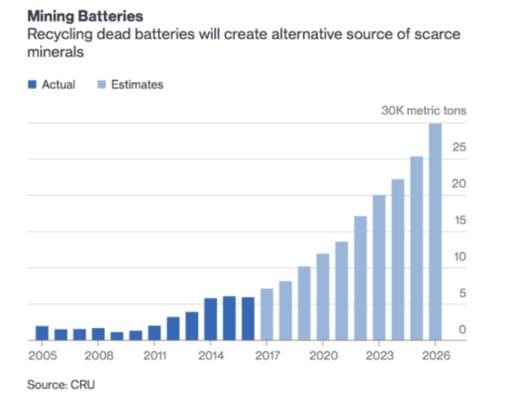Is Dysprosium The Achilles' Heel Of The Electric Vehicle Industry?

Table of Contents
The Critical Role of Dysprosium in Electric Vehicle Motors
Dysprosium plays a pivotal role in the performance of electric vehicles. It's a key component in neodymium magnets, known for their exceptional strength and resistance to demagnetization, even at high temperatures. These magnets are crucial for the efficient operation of permanent magnet synchronous motors (PMSM), a type commonly found in EVs. These motors provide the torque and power necessary for efficient and responsive driving.
- Enhanced High-Temperature Performance: Dysprosium significantly enhances the performance of neodymium magnets at elevated temperatures, preventing a critical loss of magnetic strength that could impair motor functionality, especially during demanding driving conditions or fast charging.
- Improved Efficiency and Power Output: The incorporation of dysprosium contributes to higher efficiency and increased power output in EV motors, directly translating to extended range and improved acceleration.
- Essential for High-Performance EVs: The absence of dysprosium would drastically reduce the performance of many existing EV models, impacting range, acceleration, and overall driving experience. This makes finding suitable alternatives crucial for the future of electric mobility.
The Supply Chain Bottleneck: Where Does Dysprosium Come From?
A major concern surrounding dysprosium is its geographically concentrated supply chain. China currently dominates the global mining and processing of this rare earth element, controlling a significant portion of the world's supply. This concentration creates significant vulnerabilities in the EV industry's supply chain.
- China's Dominance: China's control over dysprosium production presents a geopolitical risk. Any disruption to its mining or processing operations can lead to price spikes and shortages, directly impacting EV manufacturing.
- Supply Chain Vulnerabilities and Price Volatility: The concentrated nature of dysprosium production leaves the EV industry susceptible to price volatility and potential supply disruptions, making long-term planning and cost predictability challenging.
- Geopolitical Risks: Geopolitical tensions involving China could severely restrict dysprosium exports, creating a major bottleneck for the global EV industry and potentially hindering its growth.
The Environmental Impact of Dysprosium Mining and Processing
The extraction and processing of dysprosium are not without environmental consequences. Like many rare earth elements, dysprosium mining is an energy-intensive process with significant environmental impacts.
- Energy-Intensive Mining: Dysprosium mining requires substantial energy, often relying on fossil fuels, which contributes to greenhouse gas emissions.
- Hazardous Waste Generation: The processing of dysprosium involves the use of hazardous chemicals, creating significant waste disposal challenges and posing risks to water and soil quality.
- Habitat Destruction: Open-pit mining, a common method for rare earth extraction, can lead to significant habitat destruction and biodiversity loss. Sustainable mining practices are crucial to mitigate these environmental impacts.
Potential Solutions and Alternatives to Address Dysprosium Dependence
Addressing the dysprosium challenge requires a multifaceted approach focusing on alternative materials, improved recycling, and supply chain diversification.
- Dysprosium-Free Magnets: Research and development efforts are underway to create high-performance magnets that require less or no dysprosium. These alternatives could significantly reduce reliance on this critical material.
- Recycling and Reuse: Efficient recycling technologies are needed to recover dysprosium from end-of-life EVs and other applications, reducing the demand for newly mined resources.
- Diversification of Sources: Investing in the exploration and development of dysprosium deposits outside of China is crucial to diversify the supply chain and mitigate geopolitical risks.
- Sustainable Mining Practices: Implementing stricter environmental regulations and promoting sustainable mining practices are essential to reduce the environmental impact of dysprosium extraction.
Conclusion
Dysprosium's crucial role in high-performance EV motors, coupled with the challenges related to its supply chain and environmental impact, presents a significant hurdle for the electric vehicle industry. Addressing the dysprosium challenge requires collaborative efforts from governments, industry leaders, and researchers. The future of dysprosium in EVs hinges on the development of sustainable solutions for dysprosium sourcing, the advancement of dysprosium-free magnet technologies, and a commitment to environmentally responsible mining practices. The impact of dysprosium on the EV revolution demands immediate attention and innovative solutions to ensure a sustainable and reliable supply of this crucial rare earth element. Learn more about the challenges and solutions related to rare earth elements and the future of sustainable transportation. Let's work together to ensure a bright future for electric vehicles.

Featured Posts
-
 Increased Rent In La After Fires A Selling Sunset Star Highlights Price Gouging
Apr 29, 2025
Increased Rent In La After Fires A Selling Sunset Star Highlights Price Gouging
Apr 29, 2025 -
 Anchor Brewing Companys Closure A Look Back At 127 Years Of Brewing
Apr 29, 2025
Anchor Brewing Companys Closure A Look Back At 127 Years Of Brewing
Apr 29, 2025 -
 Tariffs Blast Radius Alberta Feels The Impact Dow Project Delayed
Apr 29, 2025
Tariffs Blast Radius Alberta Feels The Impact Dow Project Delayed
Apr 29, 2025 -
 Will Tax Credits Revitalize Minnesotas Film And Television Scene
Apr 29, 2025
Will Tax Credits Revitalize Minnesotas Film And Television Scene
Apr 29, 2025 -
 Louisville Tornado 11 Years Later Remembering The Storm And Recovery
Apr 29, 2025
Louisville Tornado 11 Years Later Remembering The Storm And Recovery
Apr 29, 2025
Latest Posts
-
 Convicted Cardinal Claims Entitlement To Vote In Next Papal Election
Apr 29, 2025
Convicted Cardinal Claims Entitlement To Vote In Next Papal Election
Apr 29, 2025 -
 Cardinals Conviction And Papal Conclave Voting Eligibility
Apr 29, 2025
Cardinals Conviction And Papal Conclave Voting Eligibility
Apr 29, 2025 -
 Convicted Cardinals Right To Vote In Papal Conclave Questioned
Apr 29, 2025
Convicted Cardinals Right To Vote In Papal Conclave Questioned
Apr 29, 2025 -
 Cardinals Claims Of Prosecutorial Misconduct Shake The Trial Of The Century
Apr 29, 2025
Cardinals Claims Of Prosecutorial Misconduct Shake The Trial Of The Century
Apr 29, 2025 -
 Cardinals New Revelations Allegations Of Prosecutorial Misconduct In The Trial Of The Century
Apr 29, 2025
Cardinals New Revelations Allegations Of Prosecutorial Misconduct In The Trial Of The Century
Apr 29, 2025
